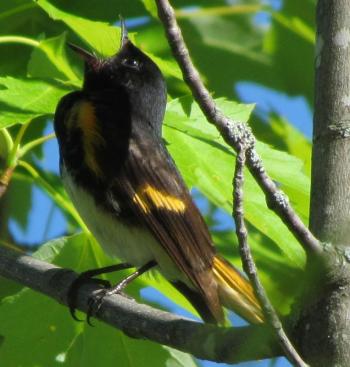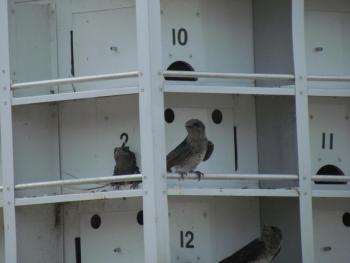Who Owns This Space?
The songs of birds give great pleasure to most people. The lilting warbles and trills of that early spring song sparrow can give a little lift to the heart as the snow melts and the daylight hours lengthen. Yet while we humans find songs uplifting and joyful, they are to birds a way to both attract a mate and, over the longer term, to defend a territorial space from others of the same species. A male will sing from perches along the boundaries of its territory, changing spots back and forth throughout the day to make sure that any and all males in adjoining territories respect the imaginary fences surrounding his space.
As often happens to us lately, we have been thinking about the territories of birds as delineated by their singing, as we have been walking our little black dog around the neighborhood. Along certain streets, we can sometimes hear up to three house wrens singing their churring songs back and forth across their territorial boundaries. On another street, lined with tall maples, there have been two American redstarts singing a high “tseep-tseep-tseep-tseep-sup” from opposite sides of the street. And of course, lots of echoing American robin songs everywhere.
By singing, these birds mark out the boundaries that others of their species will not be allowed to cross without an altercation. We humans are generally just as picky about the spaces where we live but we mark the boundaries in other ways. As we walk our dog in the neighborhood, we pass homes with fences between neighbors; others with lines of lilacs or other demarcating trees, and still others have flower gardens, even antiques. Our house came with a traditional white picket fence and flower gardens along one side, and a lilacs and forsythias along another border. And while we humans have imposed carefully surveyed lot boundaries that are registered with the local government, in practice we tend to know where property boundaries are by those fences, the extent of the lawn and garden, and other obvious features.
Our little dog is not attuned to the boundaries of human territories. He is always tugging on the leash with the hope that we will let him trot over from the sidewalk to investigate the thick green hosta plants or shrubbery around someone’s house. His sense of territory is certainly more focused on the smells of other dogs, including from where he and countless others leave their pee at locations that must be conspicuous to them as we move about the streets. He also can hear the barks of dogs as we pass by the homes and backyards of the humans with whom they cohabitate. Just yesterday, we started down a street and when a large dog barked rather aggressively from a yard that we had started to pass, our little dog decided that he would respect that dog’s space. He turned and pulled us away, down a side street.
Of course, neither we humans nor dogs usually show any respect for the boundaries of bird territories except when we humans stop and admire the singer. The one exception that we can think of is that people can learn to respect the boundaries that some birds protect around their nests and young. Gulls and terns are rather famous for diving at, and sometimes sharply pecking in the head, people who get too close to their nests. Many of these birds will turn into expert living bombers and plaster the human invader with hot, smelly guano.
Certain hawks have been known to dive at humans who get too close when they have young in the nest. Researchers who climb to their nests to band and measure the young usually wear helmets just in case one of these birds brings a sharp talon down onto the head during a dive at the intruder. Owls have been known to occasionally swoop down to try to scare off a person too close to their young. Even mockingbirds and jays have been documented to do the same.
There are a few birds that have a different sense of territorial space, one that is more like another human way of living: apartment house. In our area, one of the best examples is the purple martin. These large, dark swallows are typically found nowadays in human-made martin houses that have multiple nesting compartments close together in the same structure. Unfortunately, there are not many purple martin colonies left in Maine, as martins, like all of the swallows, have been showing major declines in the state. There is a well-known colony occupying multiple martin houses in Belgrade that is easy to see, and a few others scattered around the state.
Next time you are enjoying the beautiful songs of the birds in your backyard and neighborhood, we hope you’ll stop for a moment to consider and contrast the ways that birds and people delineate the spaces where we all live.
Jeffrey V. Wells, Ph.D., is a Fellow of the Cornell Lab of Ornithology and Vice President of Boreal Conservation for National Audubon. Dr. Wells is one of the nation's leading bird experts and conservation biologists. He is a coauthor of the seminal “Birds of Maine” book and author of the “Birder’s Conservation Handbook.” His grandfather, the late John Chase, was a columnist for the Boothbay Register for many years. Allison Childs Wells, formerly of the Cornell Lab of Ornithology, is a senior director at the Natural Resources Council of Maine, a nonprofit membership organization working statewide to protect the nature of Maine. Both are widely published natural history writers and are the authors of the popular books, “Maine’s Favorite Birds” (Tilbury House) and “Birds of Aruba, Bonaire, and Curaçao: A Site and Field Guide,” (Cornell University Press).




























